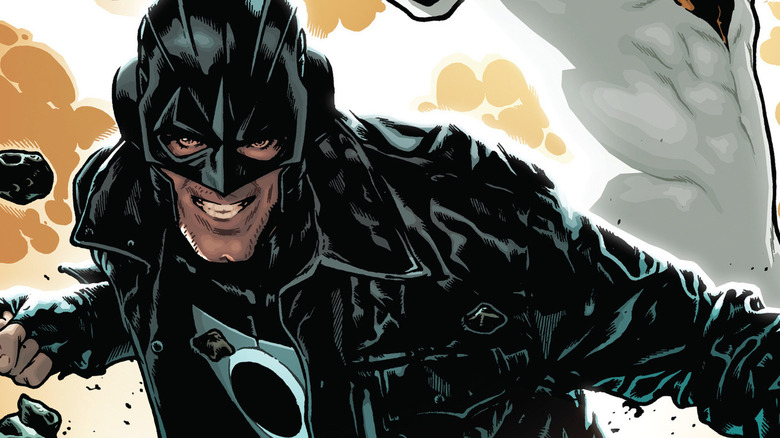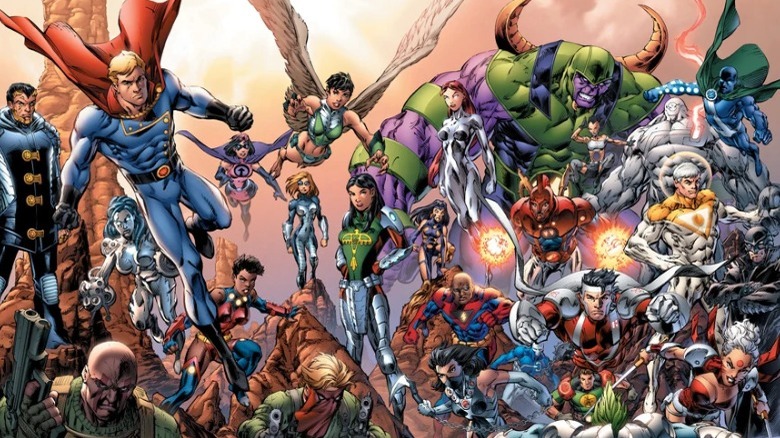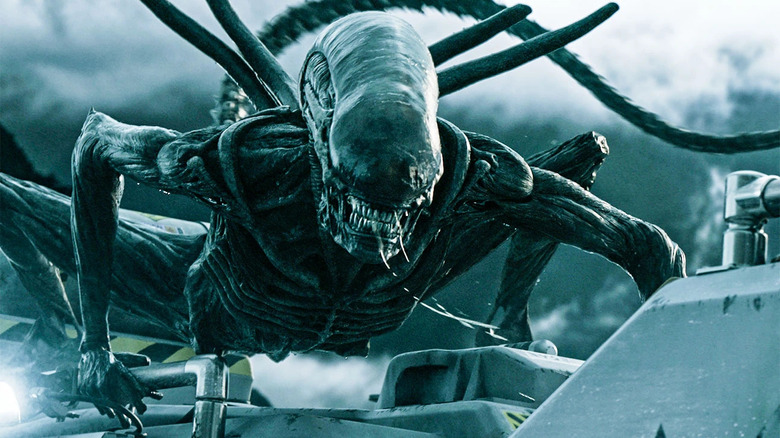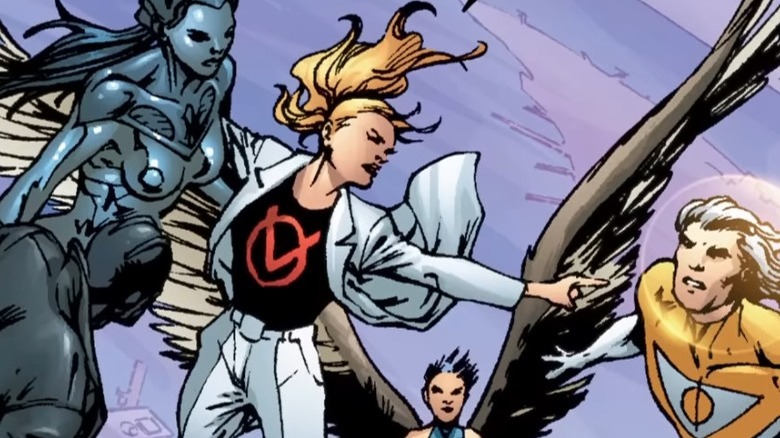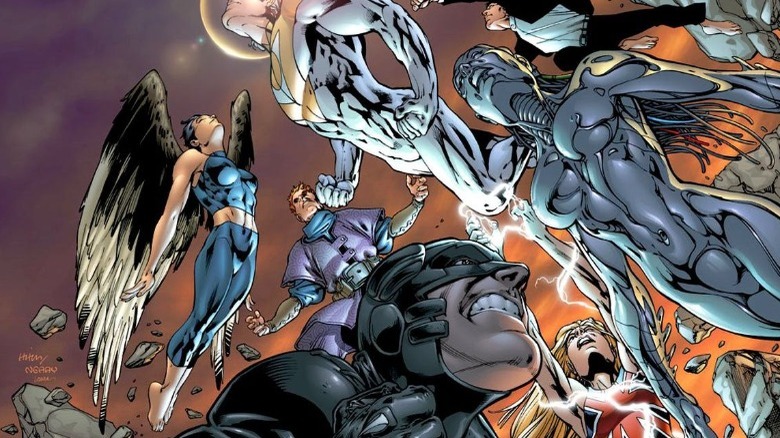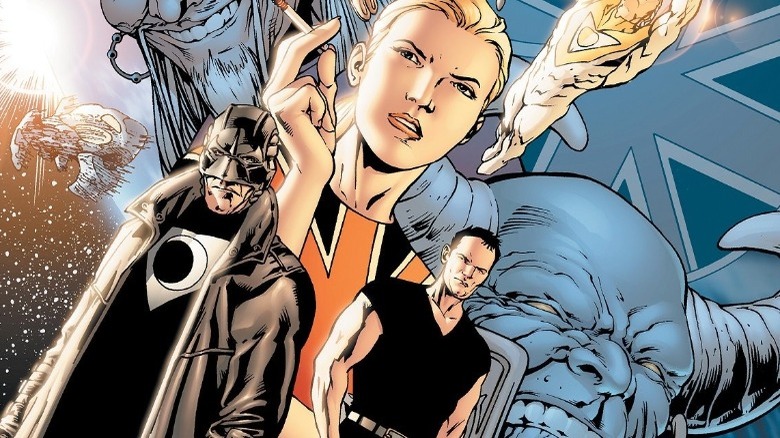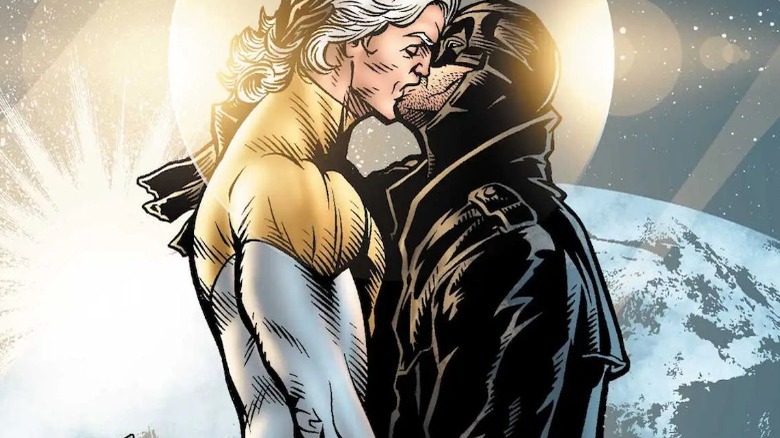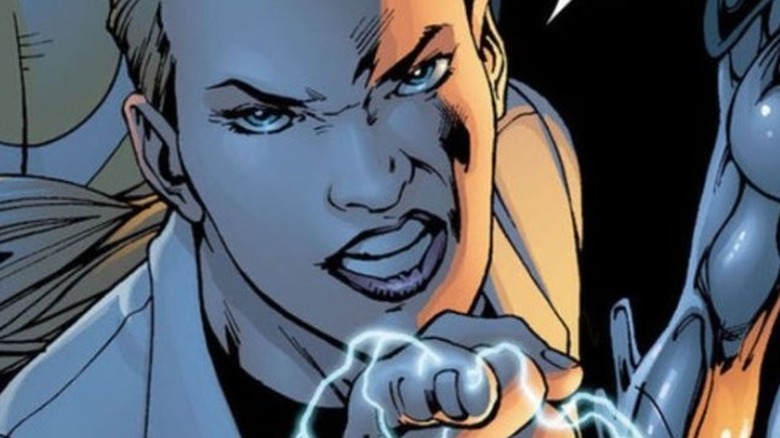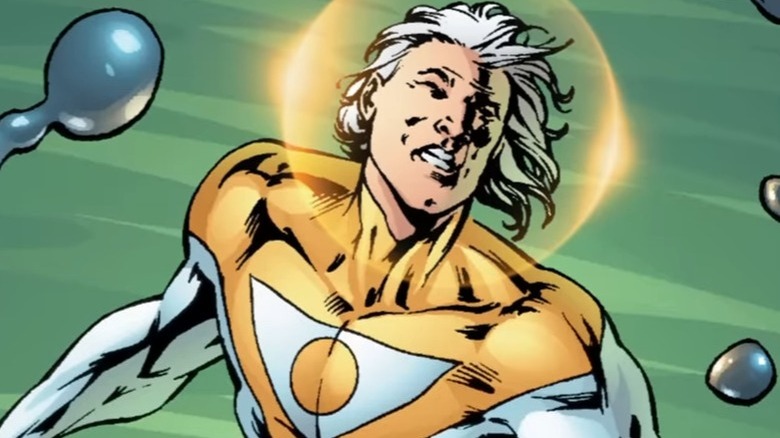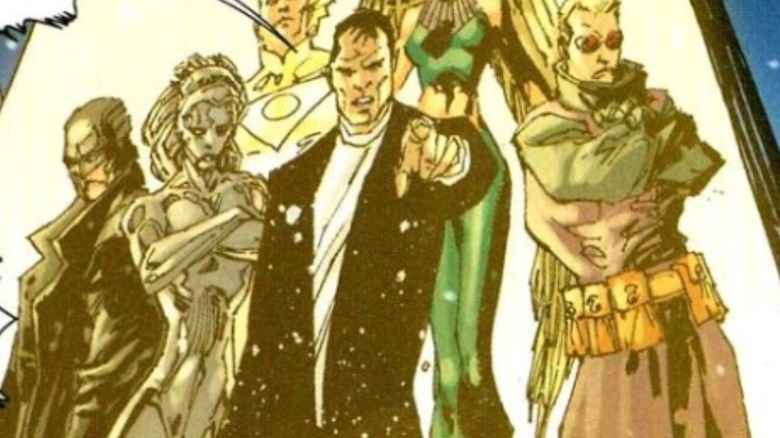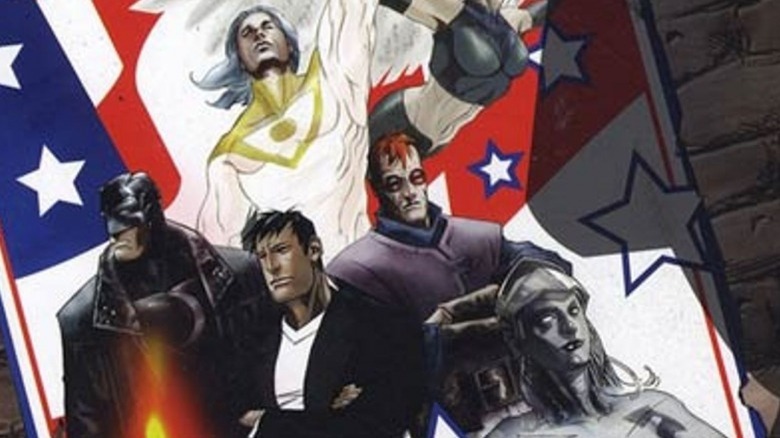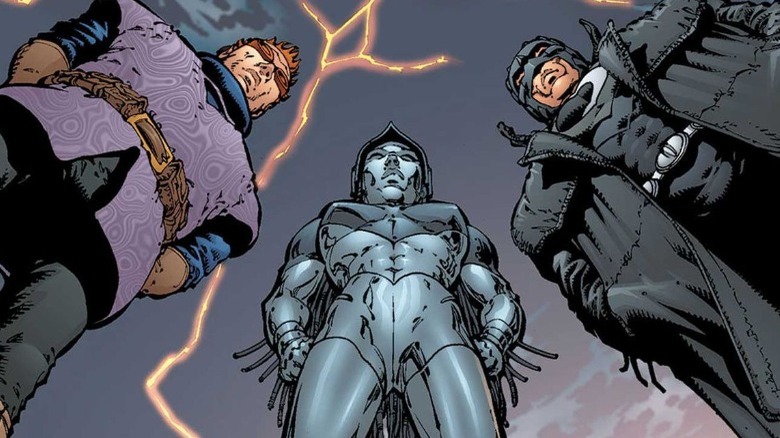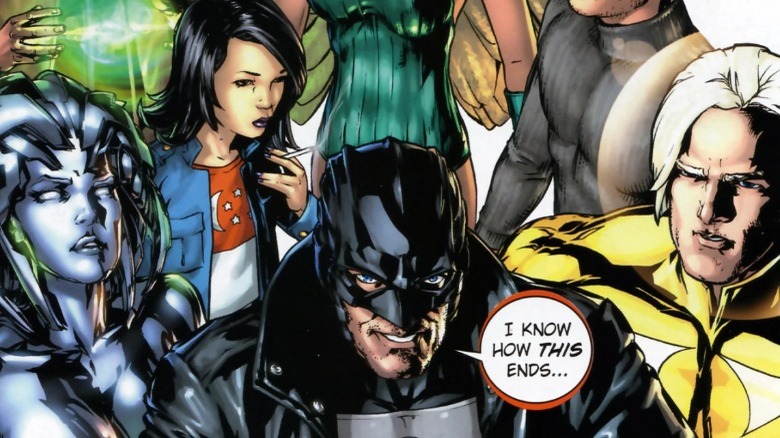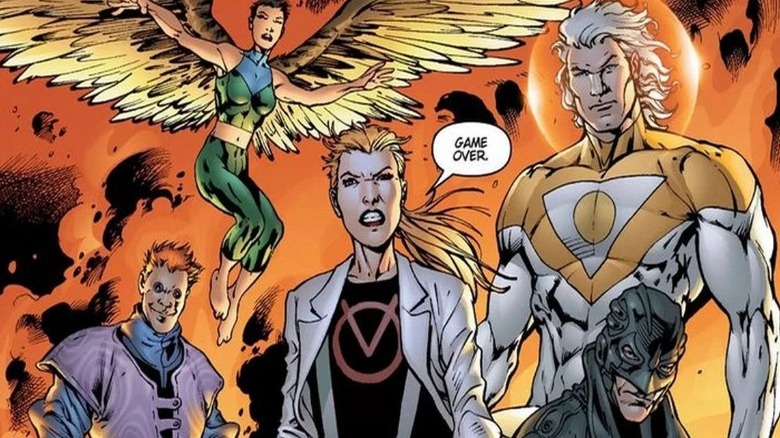The Authority: The Complete History Of DC's Brutal Group Of Superheroes
James Gunn's DC slate is blazing the way for dozens of exciting new characters to step onto the screen. Some TV shows will explore the histories of Themyscira, Amanda Waller, the Green Lanterns and even lesser known characters like the Creature Commandos. There are plenty of reasons to be excited for the new era of the DCU, but the introduction of The Authority could be the most groundbreaking change to come.
Unlike the Justice League, The Authority doesn't take non-violence all that seriously. They have their own idea of how things should work, and they'll do whatever it takes to enforce that worldview. The Authority wants to build a better world for all of humanity, but they won't hesitate to destroy any person, supervillain, or even world government that gets in their way.
The Authority is easily DC's most brutal group of heroes, and their casual approach to violence even puts Task Force X to shame. Before they potentially tear the DCU apart in their quest for justice, see how The Authority has done it all before, on the comics page.
The team started in one of DC's greatest imprints
Even big fans of DC mainstays like Batman and Superman might be left scratching their heads when asked about The Authority. That's because despite being owned by DC, the team really has very little to do with the publisher's universe of heroes. The Authority primarily belongs to the Wildstorm universe. Created in 1992 by Jim Lee, Wildstorm was an imprint of Image comics throughout the '90s (via Inside Pulse). Wildstorm saw the creation of super teams like Stormwatch and the WILDC.A.T.s before being sold to DC Comics in 1999. At that point, the imprint continued and released massive hits like "Sleeper," "Planetary," and of course, "The Authority."
Wildstorm officially ended in 2010, shortly before the DC universe went through a massive shakeup with "Flashpoint." Since then, some of the imprint's characters have reappeared in the main DC world, but the glory days of The Authority all happened under the banner of Wildstorm.
The Authority partly owes its existence to Alien
Inter-franchise crossovers are a rarity, even in comics, but without one major sci-fi crossover event "The Authority" might never have existed. Stormwatch was the main super team in the Wildstorm universe, and in 1998 writer Warren Ellis and artist Tom Raney decided it was time to take them out (via CBR). With some cooperation between DC and Dark Horse, the Xenomorphs of "Aliens" were thrown into the Wildstorm universe, ready to wreak havoc on everything they encountered. Stormwatch and the WildC.A.T.s joined forces to stop the alien threat, but even though they managed to save the day, the Xenomorphs decimated both teams.
Those are the in-universe events that led to the creation of The Authority, but there were things happening back at the Wildstorm offices that helped spur the new team into existence as well. Ellis told The Beat in 2010 that he learned "Stormwatch" wasn't selling very well, but the team at Wildstorm kept the book running anyway because they liked his writing. "I felt so bloody awful about that," he said, but learning about the book's poor sales got him thinking about how to make a drastic change, and before long The Authority was born.
Who were the founding members of The Authority?
The Xenomorph attack leaves Stormwatch in tatters, but a few surviving members of the team go on to form The Authority. The heroes who join the new team are some of the most powerful beings in the Wildstorm universe, and though some of them have surface resemblance to heroes in the DC universe, for the most part they're unlike any other characters in more mainstream comics.
Jenny Sparks, Jack Hawksmoor, and Swift create The Authority with the intention of combining their abilities to change the world. Jenny is a kind of superhuman known as a Century Baby. She doesn't age, and her powers allow her to manipulate electricity and even travel through electric cables. Swift has wings that make her look like DC's Hawkman, but she was born from an ancient Tibetan egg, and she can fly faster than any Speedster.
Jack, though, has the strangest origin story and powerset of all. As a child he was abducted by beings from the future who implanted his body with powerful technology in the hopes that he'd be able to save the world. As an adult, he's the God of Cities, and draws on the energy of large cities to fly, heal, teleport, use telepathy, and perform all sorts of other pseudo miracles.
Their battles had serious consequences
Today shows like "The Boys" are known for going all in on the destructive capabilities of superheroes, but before The Seven were turning regular humans into collateral damage, "The Authority" showed comic book fans just how dangerous a world of superheroes really would be.
In the very first issue of "The Authority" half of Moscow is destroyed when longtime Stormwatch enemy Kaizen Gamorra attacks the city with an army of bioengineered soldiers. The attack becomes the first call to action for the newly-formed super team, but even when they get involved the destruction continues. Two issues later large parts of London are leveled as The Authority battles the soldiers and tries to uncover the rest of Kaizen Gamorra's plan.
That first story arc set a theme for the rest of The Authority's existence. Their enemies, both Earthbound and extraterrestrial, are constantly seeking to cause as much death and chaos as possible. The Authority fights to defend all of Earth, but their own abilities end up causing plenty of damage, even though in the big picture they're saving the day.
They once fought God
The Wildstorm universe was home to many characters that made mainstream superheroes look boring and unimaginative. Kaizen Gamorra, an island dictator and evil super genius, is among the most tame creations in the imprint. Many of The Authority's adventures took them to strange worlds and introduced them to stranger enemies, but one of their standout encounters happened during Warren Ellis' initial run with the characters.
How many superbeings can say they fought God and won? In "The Authority" #9 a massively powerful extraterrestrial being approaches Earth, destroying satellites and causing tentacles to burst from the moon's surface as it gets nearer. In issue 10, the team learns that what they're up against is the being that created the solar system and Earth itself. The only problem is that this being isn't exactly God in the ways humans had imagined — it planned for the Earth to be its retirement home, and now that it's ready to finally kick back, there's an infestation of life all across its planet.
Of course, The Authority isn't willing to stand by and let God wipe out all of humanity to perfect its pleasure planet. In issue 12 they fly their ship into the creature's veins, stumbling across entire civilizations that inhabit its body while they search for a brain. Eventually Jenny Sparks electrocutes the creature to death, but she dies in the process.
The team had DC's first openly gay couple
Warren Ellis created The Authority and had Jenny Sparks, Swift, and Jack Hawksmoor act as its leaders, but he also brought a number of other characters into the fold. Jereon Thornedike, the Doctor, is a powerful magic user who regularly helps the team out of a tight spot. Angela Spica, the Engineer, has a body made of liquid metal thanks to nanites in her blood. Apollo and Midnighter are Superman/Batman analogues, but Ellis instilled the characters with some definite romantic tension.
When Mark Millar took over "The Authority" after the Ellis run finished, he made the romantic relationship between Apollo and Midnighter an even more important part of the story. The two were DC's first gay couple, but the publisher was actually slow to accept the characters, going as far as to remove a panel of the two kissing that was meant to be in issue 13 (per Wild Times: An Oral History of Wildstorm Studios). As readers continued to be invested in the relationship, DC relaxed its stance, and the relationship between Apollo and Midnighter became one of the most celebrated aspects of "The Authority." In 2002 Millar closed out his run on the story in issue 29 by having the two get married.
Too violent for the times
By the time Mark Millar took over writing "The Authority" with issue 13, the book had already become known for its high stakes and high levels of violence. Millar wanted to up the ante, and from time to time DC stepped in and forced him to tone things down.
Millar's first brush with editorial control came right at the start of his run. In his first issue of "The Authority" Millar had the team fighting a set of Avengers lookalikes, and DC demanded that red filters be put over some panels to tone down the violence (via Sequart). The changes didn't have any effect on the overall storyline, but they did set a precedent for parts of "The Authority" being nixed.
The biggest changes pushed by DC actually had little to do with Millar's storytelling. The publisher canceled a special issue called "The Authority Widescreen" and pushed back the release of issue 27 because both featured scenes of mass destruction in New York City, and had been scheduled to be published shortly after 9/11. After a lengthy delay, issue 27 finally hit shelves, but "Widescreen" never made it to publication (per Sequart again).
They came into conflict with the Earth's governments
From the very beginning of "The Authority," what really set the team apart from any other super group was that they had their beliefs about right and wrong that they were willing to enforce on the world. The Authority protects the Earth from countless threats, but the people that they're protecting don't always agree with the tactics they use.
Beginning in issue 22 the "Brave New World" storyline puts The Authority in conflict with governments all around the world, and the superheroes aren't willing to step down. Concerned with how much power The Authority has amassed, the G7 nations build their own team of superheroes, intending to replace The Authority and win back more control over the planet.
The battle between the G7 Authority and the original team plays out over the final issues of Mark Millar's time with the characters. In typical fashion, things get extremely violent, and Midnighter brutally murders several of the G7 Authority members in issue 28 after discovering that they'd kidnapped and tortured Apollo. By the end of the story, the G7 Authority has been entirely defeated, which puts the original Authority in a strange position for superheroes. They may be trying to save the world, but now they're also acting as pseudo-dictators of the entire planet.
They seized control of the United States
Even after feuding with the G7, The Authority let the world continue to run as normal. In reality, there were no drastic changes for everyday people in the fallout of the battle. The status quo wasn't meant to last forever, though.
In 2004 writer Ed Brubaker kicked off a storyline called "Coup d'Etat" and turned The Authority into, well, authoritarians. Tao, a former WILDC.A.T.s member and budding supervillain, convinces the President of the United States to explore the possibility of taking over the Bleed. On the President's orders, the U.S. sends an experimental ship into the Bleed, but a malfunction causes a massive explosion and creates a breach in the Bleed over Florida. The death count is tremendous.
Following the president's horrible mistake, The Authority announces that they're tired of letting regular humans make awful decisions for the entire world. They think everything will go better if the government steps aside and allows them to run the country. After everything that happened with the G7, the president knows he can't win against The Authority, so the U.S. falls under their control. The team ends all elections but also puts as much effort as possible into caring for all the country's citizens. For a while, it seems like The Authority's takeover is actually a good thing, but that peace doesn't last.
Facing Revolution
After taking control of the United States, The Authority believes that they can build something like a utopian society, but they'll have to do it against the will of the American people. It turns out that no matter how safe The Authority can make the country, some people don't like handing over their rights to a team of superheroes.
Ed Brubaker continued exploring The Authority's takeover in a 12-issue miniseries called "The Authority: Revolution." At first the entire world is shaken by what The Authority has done in the U.S., but most other countries try to stay as far away from the conflict as possible. Within the country, however, a rebellion is brewing.
In the first issue of the series a new group of heroes called the Sons of Liberty team up to resist The Authority's control. The revolution at home dovetails with some time travel chaos and ultimately upsets The Authority's new government. By the end of the series, the U.S. government has been reinstated, and The Authority have had their egos somewhat checked.
WorldStorm
There can only be so much downtime in comics. Some new threat always needs to enter the frame to shake things up and send heroes off on a new mission. The Authority barely had time to settle after the events of "Revolution" before the entire WildStorm universe was rocked to its core.
The WorldStorm event was meant to bring dramatic changes to every series under the Wildstorm banner, but for "The Authority," most of the drama happened behind the scenes (via Sequart). Grant Morrison and Gene Ha were brought in to create another 12-issue arc for the team, but issue 2 only landed on shelves after a five-month delay, and issue 3 never came out at all.
While fans waited for Morrison's story to continue, other "Authority" titles launched and did their best to continue the plot sometime in the future without really addressing how Morrison's run would have been resolved. Morrison never returned to their story, and fans had to wait years before getting any answers to the questions they introduced.
The Lost Year
In 2006 Grant Morrison's first issue of "The Authority" sent the team to an alternate universe that looked much like our own. The team becomes stuck in a world without superheroes, and they aren't exactly clear on how that's happened or how they could possibly get home. After giving fans that intriguing premise, Morrison left the book, and it wasn't until 2008 that writer Keith Giffen was tapped to fill in the gaps with a story now called "The Authority: The Lost Year" (via The Newest Rant). Giffen's first issue picked up right where Morrison's story had left off, but it didn't hit shelves until 2010.
"The Lost Year" takes The Authority across the multiverse and mixes in some lighthearted stories with some of the darkest moments in The Authority's history. In issue 4 the team manages to leave the powerless Earth, but they kill the entire planet in the process. Later they meet a family-friendly version of themselves, and in one world they see themselves still ruling the United States. After a year abroad, the team finally finds their way home.
World's End
All good things must come to an end. The Authority and the entire Wildstorm universe had a great run, but in 2011 the DC "Flashpoint" crossover event merged both universes and officially put a close to Wildstorm.
Before the two universes were merged together in the New 52, Wildstorm had one last major event called "World's End." An apocalyptic event is coming to Earth, and the planet's various super beings are all preparing for it in their own way. The WILDC.A.T.s have become the primary protectors of the planet, as The Authority is scattered while dealing with multiple threats.
The Authority's main plot line through the event focuses on Apollo and Midnighter. Apollo has become infected with something called the Warhol Virus, and as Midnighter leaves the team in search of a cure, Kaizen Gamorra returns for one last opportunistic attack. Eventually The Authority defeats Kaizen and comes to help Midnighter. Apollo is cured just in time for the Wildstorm universe to be swept away.
